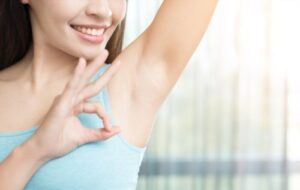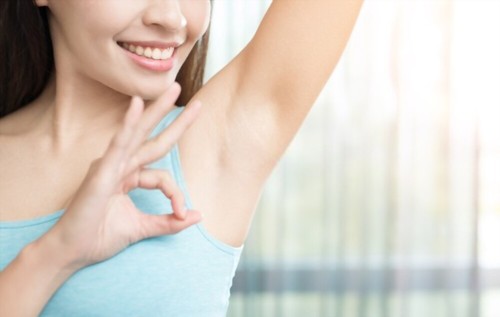 Sweating or perspiring (ladies perspire and never sweat!!) – not particularly nice, but a normal and necessary bodily function. It’s the body’s cooling mechanism, without this the body would not be able to maintain the optimal internal temperature of 98.6 degrees Fahrenheit and we’d be at risk of heatstroke, a potentially life-threatening condition which, if left unchecked, can lead to vital organs shutting down.
Sweating or perspiring (ladies perspire and never sweat!!) – not particularly nice, but a normal and necessary bodily function. It’s the body’s cooling mechanism, without this the body would not be able to maintain the optimal internal temperature of 98.6 degrees Fahrenheit and we’d be at risk of heatstroke, a potentially life-threatening condition which, if left unchecked, can lead to vital organs shutting down.
We have approximate y two to four million sweat glands made up of mainly eccrine glands and apocrine glands. Eccrine glands are distributed all over the body, with abundant numbers in the armpits, soles of the feet, palms of the hands, forehead and cheeks, and secrete an odourless clear fluid composed of 99% water in addition to sodium, chloride, potassium, calcium, magnesium, protein, urea, and ammonia. It is this secretion which we know as sweat that evaporates to cool the body. The most common places for sweating are the armpits, face, palms of the hands and soles of the feet. 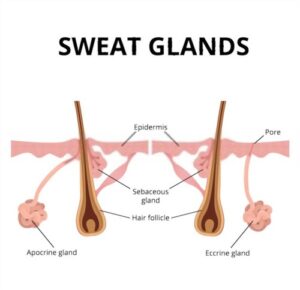
Apocrine glands are located only in the armpits, mammary, anal and genital region. They secrete a thick oily fluid through the hair canals, composed of lipids, proteins and steroids, and respond to emotional stimuli such as fear and anxiety. It is the secretion from the apocrine glands which, when it comes into contact with the bacteria living on our skin becomes the odoriferous body odour – most commonly known just as BO. These secretions become more potent from the onset of puberty, which is why young children don’t suffer with BO.
External influences play a huge role in how much we sweat – obviously high summer temperatures will send our sweat glands into overdrive, along with exercising of course. Incidentally during exercise in a moderate temperature the average person will lose approximately 1.5 to 2 litres of fluid through sweat, in hot temperatures this can double, so it’s important to replace the fluid to prevent dehydration.
Incidentally during exercise in a moderate temperature the average person will lose approximately 1.5 to 2 litres of fluid through sweat, in hot temperatures this can double, so it’s important to replace the fluid to prevent dehydration.
Diet can also increase sweating, for instance when we eat spicy foods, it can trick the body into thinking that the internal body temperature has increased. Alcohol increases the heart rate and dilates the blood vessels, the same reaction as with physical exercise, which again tricks the body into sweating.
But there are other factors which influence how much we sweat: Body size – a higher body mass means more heat to move it and a larger surface area to cool down; Age – tolerance to heat decreases as we age; Health – medical conditions and even mental health can increase sweating; Hormonal changes – hormone fluctuations such as menstruation, menopause and pregnancy can all increase the body temperature; Muscle mass – muscle produces more heat than fat.
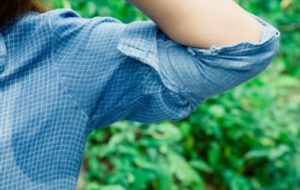 Some people suffer from a condition called primary focal (essential) hyperhidrosis which causes excessive sweating, usually approximately four times more than the average person, due to overactive nerves stimulating sweating for no apparent reason, although emotions such as nervousness or stress can make the problem worse. It commonly occurs on the palms of the hands, soles of the feet, underarms, face and scalp. There is also secondary hyperhidrosis which is due to a medical condition such as menopause, diabetes, pregnancy or infections. Whilst this condition may be psychologically damaging, so long as the lost fluid, nutrients and electrolytes are adequately replaced (try a sports drink!) There is no health issue, although the skin may be prone to more infections.
Some people suffer from a condition called primary focal (essential) hyperhidrosis which causes excessive sweating, usually approximately four times more than the average person, due to overactive nerves stimulating sweating for no apparent reason, although emotions such as nervousness or stress can make the problem worse. It commonly occurs on the palms of the hands, soles of the feet, underarms, face and scalp. There is also secondary hyperhidrosis which is due to a medical condition such as menopause, diabetes, pregnancy or infections. Whilst this condition may be psychologically damaging, so long as the lost fluid, nutrients and electrolytes are adequately replaced (try a sports drink!) There is no health issue, although the skin may be prone to more infections.
Unfortunately there is no medical cure for hyperhidrosis, but solutions available include: prescription strength antiperspirants; botox to temporarily block the nerves which cause the sweating; prescription creams to block the nerves; microwave therapy to destroy the sweat glands; or in worst case scenario, medical treatment to remove the sweat glands or permanently block the nerves.
Sweating in itself, as stated, is an important bodily function without which we could not survive. The issue comes when the sweat interacts with bacteria on the skin’s surface and causes the dreaded pong of BO. This also causes an issue with foot odour, especially if the feet become damp from sweat and become a breeding ground for bacteria and fungi!
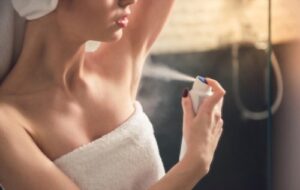 For the underarms we have deodorants which contain antimicrobial agents or ethanol to destroy the bacteria and thus prevent any smell, plus they usually contain a fragrance to mask any smell, as well as antiperspirants which typically contain aluminium to block the sweat glands and prevent moisture through sweating. Most of the products you see on the shelves will actually be deodorant-antiperspirant combinations.
For the underarms we have deodorants which contain antimicrobial agents or ethanol to destroy the bacteria and thus prevent any smell, plus they usually contain a fragrance to mask any smell, as well as antiperspirants which typically contain aluminium to block the sweat glands and prevent moisture through sweating. Most of the products you see on the shelves will actually be deodorant-antiperspirant combinations.
The problem is that these products are full of artificial products including parabens and diethanolamine (both linked to cancer), phthalates and triclosan (both linked to hormone disruption), plus alcohol and fragrance which could all be dangerous to long-term health.
The body has no use for aluminium and there has been much discussion regarding a link between the use of aluminium in antiperspirants and breast cancer, and although scientists
hypothesise that there may be a connection, the American Cancer Society does categorically state that there has not been enough scientific evidence provided to support this claim. Aluminium is also responsible for the yellow stains which we may find on the underarms on white clothing – its caused by a chemical reaction between the salt in sweat and the aluminium.
So what else can we do to help with body odour? Bathe regularly and ensure you dry yourself well, especially under the arms and between the toes. Wear loose, natural materials for clothing, and suited for the activity which you are undertaking. There is some sports clothing available which is designed to draw moisture away from the body.
Choose footwear in natural materials to allow the feet to breathe, and change socks at least everyday, more frequently if odour is an issue, and dry the feet thoroughly if changing socks during the day, and use foot powders to help absorb the sweat. Air the feet as often as possible. Allow shoes to air and dry out, and if possible change daily.
Meanwhile, nature has also provided us with a range of solutions that can help to cool the body:
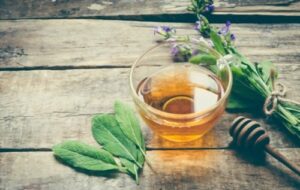 Sage Tea (Marmaraya)
Sage Tea (Marmaraya)
Sage tea has a long history of use for reducing sweating. It is actually approved for the treatment of hyperhidrosis by the German health authorities and is a vital ingredient in many formulations for the relief of nights sweats and hot flashes during menopause. The leaves contain tannic acid which gives it astringent properties, thus effectively constricting the sweat glands and reducing sweating. It also has antibacterial and antifungal properties. It is best drunk cold to reduce sweating, and at least three cups should be consumed daily. Try Marmaraya Tea – desert sage – indigenous to the area of Saint Catherine Mountains in the Sinai area of Egypt.
Note: Not suitable during pregnancy as may cause uterine contractions.
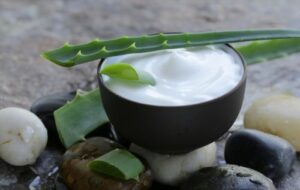 Aloe Vera
Aloe Vera
Aloe vera, can help to instantly cool the skin, and therefore decrease body heat, effectively dissuading the production of sweat, in addition to tightening the pores and reducing perspiration secretion. It also has antibacterial properties. Apply topically to any hot spots.
Essential Oils
There are a number of essential oils which can help in several ways to combat sweating or even extensive sweating. For example:
Lavender Essential Oil
According to Ayurveda it decreases heat in the body, in addition to having antibacterial properties. Scientific studies have shown that inhalation decreases skin temperature due to its effect on the nervous system. Has a wonderful soft powdery floral aroma which calms the mind.
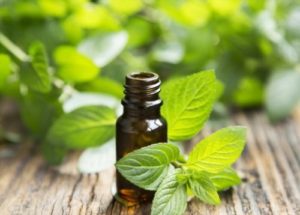 Peppermint Essential Oil
Peppermint Essential Oil
Contains menthol which provides a powerful cooling and refreshing effect, and can alter the brain’s perception of body heat to trick the brain into thinking that its cooler than it is, thus reducing sweat production. Its cooling and analgesic effects have been confirmed by science. It is antibacterial and antifungal, with a minty, refreshing aroma. Widely used in foot products to revive tired, sore feet. Mentally stimulating, peppermint calms the nerves, and increases concentration and focus.
Eucalyptus Essential Oil
Contains eucalyptol which works in a similar way to menthol, altering the brains perception of body heat and reducing sweat production. It also boosts circulation which can help to reduce body temperature. This oil has antibacterial and antifungal properties. Eucalyptus has a minty, camphorous scent, which stimulates the senses, calming and soothing the mind, whilst re-energising and refreshing the body.
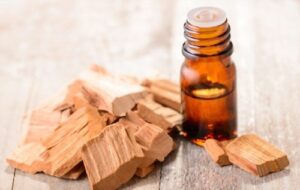 Sandalwood Essential Oil
Sandalwood Essential Oil
According to Ayurveda it can “stop excessive sweating” and is said to cool Pitta Dosha (problems related to excessive heat and acidity in mind and body, including hot flashes). It has a long history as a cooling agent to reduce perspiration. Sandalwood has a subtle warm woody earthy aroma, and reduces anxiety, fear and panic attacks.
Note that essential oils should not be used undiluted on the skin, but should be diluted in a carrier oil such as jojoba, sweet almond, or even aloe vera first.
Worried about the effects of synthetic deodorants/antiperspirants, but obviously still need something to help control body odour? Why not make your own natural deodorant, blended to meet your own specific needs:
Ingredients:
3 tablespoons coconut oil
2 tablespoon shea butter (or just use 5 tablespoons of coconut oil if prefered)
3 tablespoons baking soda
2 tablespoon arrowroot powder or cornstarch
Essential oils of choice
deodorant container
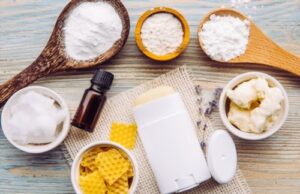
Directions for how to make deodorant with essential oils
- Melt shea butter and coconut oil in a double boiler. I make my own by placing a glass bowl over a pot of water.
- Remove from heat and add in baking soda and arrowroot powder.
- Add essential oils of choice. I’ll list my favorite combos below!
Instructions:
- Melt the coconut oil and shea butter in a double boiler (or place a glass bowl over a pot of hot water)
- Remove from heat and stir in baking powder and arrowroot powder (or cornstarch)
- Add essential oils of choice.
- Press into an clean, empty stick deodorant container or a clean mason jar.
- Allow to solidify. Since coconut oil and shea butter can both melt at warmer temperatures, it is recommended to store in a fridge.
Need some more inspiration for essential oils for your home-made natural deodorant?
Astringent – helps to constrict the pores and reduce the amount of sweat coming through them:
Bergamot, grapefruit, lemon, rosemary
Antibacterial – essential to kill the bacteria which causes the odour:
Peppermint, tea tree, lavender, eucalyptus, lemongrass, lemon, citronella, geranium
Calming – to calm irritation and itchiness:
Bergamot, cinnamon, clove, eucalyptus, lavender, lemongrass
Anti-anxiety – to reduce sweating due to pychological factors:
bergamot, eucalyptus, geranium, grapefruit, frankincense, jasmine, lavender, lemongrass, marjoram, orange, patchouli, peppermint, rose, rosemary, sage, sandalwood, ylang ylang.
Just a quick note – it should be realised that when you first switch to a natural deodorant, it will take a while for the body to detox, so it may be necessary to reapply several times a day. Remember that all of that aluminium previously sed to clog your sweat glands, and trapped bacteria, needs to be discarded by the body first, and this can take up to three weeks. But it’s worth persevering for a healthy solution, not only is the deodorant helping to control the odour but its also imparting health benefits to the skin at the same time..
So pick your favourites, and make your own natural and healthy deodorant today!
